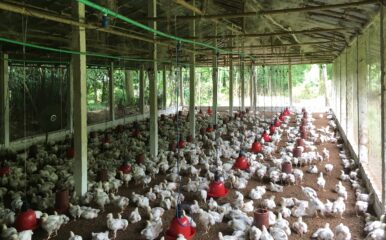
Poultry farmer training in Bangladesh: An initiative to explore farmers’ knowledge
Published on 16/11/2023

Poultry plays a significant role in both promoting agricultural development and addressing malnutrition in Bangladesh. Poultry meat accounts for more than a third of Bangladesh’s meat consumption. To gain understanding of current poultry farming procedures and improve farmer skills, the One Health Poultry Hub in Bangladesh collaborated with the country’s Department of Livestock Services (DLS) to implement a comprehensive training programme for poultry farmers in the Chattogram division – the first such a training effort within the region.
The programme was held over two days in 12 of the 20 upazilas in the Chattogram division over a period of seven months and it focused on farmers specialising in broiler, layer and Sonali poultry farming. A total of 173 farmers were trained: 163 men and 10 women.
During the first day of each two-day event, we disseminated up-to-date principles of farm management, encompassing feeding, housing, vaccination and de-worming practices, via a presentation to the farmers. In addition, we implemented a problem-based learning (PBL) approach, whereby the farmers were divided into groups with each group assigned scenarios relating to chicken diseases and vaccination strategies. The farmers were tasked with resolving these scenarios and presenting their results and recommendations. We placed significant focus on biosecurity practice and the importance of implementing farm biosecurity measures.
Evaluating farm management
On day two, in addition to presentations and PBL activities, a field visit was incorporated. This involved groups of farmers evaluating a visited farm based on the knowledge they had acquired from our training sessions. To facilitate the assessment, the farmers were provided with a scoring sheet, with marks linked to different aspects of farm management, including the housing system, feeding and water management system, vaccination processes, sick animal management and biosecurity practices. Each criterion had specific scenarios that needed to be met to achieve a perfect score of two with missing scenarios resulting in the farm receiving a score of either half or zero marks.
During the evaluation process, farmers had the opportunity to consider their visited farm’s performance and identify areas for improvement. Some farmers expressed different perspectives to that of the farm owner as they reflected knowledge acquired during the training programme. After the assessment, we collected feedback from the participants by means of an interactive and inclusive presentation.
Day two also saw a virtual session on Zoom with a distinguished poultry expert from Hub partner Chattogram Veterinary and Animal Sciences University (CVASU). During this, farmers had the opportunity to directly address their inquiries about farm management to the specialist.
Communicating the training
To enhance the comprehensibility of our training programme, we used a variety of communication techniques, including posters, video documentaries, leaflets and PowerPoint presentations.
Results of this training initiative were later disseminated to key stakeholders, including DLS officials, farmers, feed dealers, private and non-private veterinarians, academicians and researchers, at a day-long event. For this event, we also invited some of the more impressive farmers who had participated in our training so they could offer up their insights about the programme.
During this meeting too, a focus group discussion was conducted with various stakeholders, including farmers, representatives from the DLS, academics and feed dealers, and the results of this discussion were also fed back to the audience.
Over this seven-month training programme, our primary objective was to disseminate the most effective methods of farm management among the participating farmers. As it was the first such a training effort within Chattogram, we anticipated that stakeholders would actively support our farmers in subsequent endeavours. Our efforts are ongoing and we have already initiated the process of gathering post-training feedback from the farmers. This will help us to present a thorough impact narrative from our standpoint, and inform the development of future farmer training programmes.
In addition, the training served to demonstrate the necessity for consistent guidance in poultry farm management and biosecurity for our farmers. It became evident over training period that a significant portion of farmers had little enthusiasm in seeking veterinary assistance when it was required. Following the training and dissemination session, a noticeable change was observed among the participants with respect to their perception and attitudes towards veterinarians. Simultaneously, veterinary officers at governmental level demonstrated their dedication to maintaining this form of training within their respective communities.


